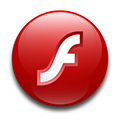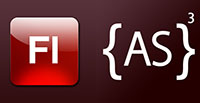
A Flash animation or Flash cartoon is an animated film which is created by Adobe Flash or similar animation software and often distributed in the .swf file format. The term Flash animation not only refers to the file format but to a certain kind of movement and visual style. With dozens of Flash animated television series, countless more Flash animated television commercials, and award-winning online shorts in circulation, Flash animation is enjoying a renaissance.
In the late 1990s, when for most Internet users, bandwidth was still at 56 kbit/s, many Flash animation artists employed limited animation or cutout animation when creating projects intended for web distribution. This allowed artists to release shorts and interactive experiences well under 1 MB, which could stream both audio and high-end animation.
Flash is able to integrate bitmaps and other raster-based art, as well as video, though most Flash films are created using only vector-based drawings which often result in a somewhat clean graphic appearance. Some hallmarks of poorly produced Flash animation are jerky natural movements (seen in walk-cycles and gestures), auto-tweened character movements, lip-sync without interpolation, and abrupt changes from front to profile view.
Flash animations are typically distributed by way of the World Wide Web, in which case they are often referred to as Internet cartoons, online cartoons, or webtoons. Web Flash animations may be interactive and are often created in a series. A Flash animation is distinguished from a Webcomic, which is a comic strip distributed via the Web, rather than an animated cartoon. Flash animation is now taught in schools throughout the UK and can be taken as a GCSE and A-level.

ActionScript is an object-oriented language originally developed by Macromedia Inc. (now owned by Adobe Systems). It is a dialect of ECMAScript (meaning it is a superset of the syntax and semantics of the language more widely known as JavaScript), and is used primarily for the development of websites and software targeting the Adobe Flash Player platform, used on Web pages in the form of embedded SWF files. The language itself is open-source in that its specification is offered free of charge and both an open source compiler (as part of Apache Flex) and open source virtual machine (Mozilla Tamarin) are available.
ActionScript was initially designed for controlling simple 2D vector animations made in Adobe Flash (formerly Macromedia Flash). Initially focused on animation, early versions of Flash content offered few interactivity features and thus had very limited scripting capability. Later versions added functionality allowing for the creation of Web-based games and rich Internet applications with streaming media (such as video and audio). Today, ActionScript is suitable for use in some database applications, and in basic robotics, as with the Make Controller Kit.
Flash MX 2004 introduced ActionScript 2.0, a scripting language more suited to the development of Flash applications. It is often possible to save time by scripting something rather than animating it, which usually also enables a higher level of flexibility when editing.
Since the arrival of the Flash Player 9 alpha (in 2006) a newer version of ActionScript has been released, ActionScript 3.0. This version of the language is intended to be compiled and run on a version of the ActionScript Virtual Machine that has been itself completely re-written from the ground up (dubbed AVM2). Because of this, code written in ActionScript 3.0 is generally targeted for Flash Player 9 and higher and will not work in previous versions. At the same time, ActionScript 3.0 executes up to 10 times faster than legacy ActionScript code due to the Just-In-Time compiler enhancements.
Flash libraries can be used with the XML capabilities of the browser to render rich content in the browser. This technology is known as Asynchronous Flash and XML, much like AJAX. Adobe offers its Flex product line to meet the demand for Rich Internet Applications built on the Flash runtime, with behaviors and programming done in ActionScript. ActionScript 3.0 forms the foundation of the Flex 2 API.
Back To Top